
The DNS-325 supports external hard drives formatted in either NTFS or FAT 32. This could be a nuisance when a backup is being done or a large amount of data is being transferred to or from the server. It seems that the server restarts certain or all of its services when changes to its settings are applied. We call it a "soft" restart because during this time, the Web interface was still working like normal. For example, when we added a new user, the server stopped serving data when the new user account was being created. We noticed that the server requires some sort of "soft" restart when changes are applied. The server's Web interface could also be more responsive and intuitive. Home users can only set the server up as a simple network storage device that hosts streamable content. However, all of its advanced features require a little networking know-how to figure out. It supports Time Machine backup, and it has the ability to share photos and host blogs over the Internet. To be fair, however, it does include many things home users look for in a NAS server, including the ability to work as a media-streaming server, and an FTP and Web server. Its network sharing is also limited: you can create only one share folder per volume, and you can't change the name of this share folder. The server doesn't offer an easy way to access its data remotely, it has no support for an IP camera, and there's no self-downloading capability. Alternatively, you can get to this Web interface by pointing a connected computer to the server's IP address, which is automatically assigned by the network's router (DHCP server).Ĭonsidering it's been a long time since the DNS-323 was released, the DNS-325 is rather behind in terms of features and ease of use compared with recent NAS servers. We were able to get the server up and running with two 2TB hard drives within about 20 minutes, including the time spent for the RAID setup to be built.Īfter that, you can use the included D-Link Easy Search Utility to launch the server's Web interface that allows you to further customize the server.

Most advanced users can figure this out themselves, and novice users can just follow the included setup software, which walks you through the process step by step. Setting up the DNS-325 is easy, though there are quite a few steps, especially when you choose to get your own hard drives.
DLINK 325 HARD DISK LED RED SHARECENTER UPGRADE
This is because once set up, there's no way you can upgrade the hard drives without having to rebuild the RAID. We'd recommend the former as it gives you the freedom of getting your own hard drive, and you should get the largest according to your storage needs. The DNS-325 comes in two configurations, one with no storage and the other with a 1TB hard drive included. There's no option to perform a "slow" and safe RAID build, however. This is likely because the DNS-325 automatically skips disk checking during the RAID build, which might subsequently pose problems, especially in a RAID 0 setup, if one of the disks has bad sectors. Other servers would take hours to do the same job. In our trials with two 2TB hard drives, the server could create a RAID configuration within just a few minutes, which is very fast. You'll also have the options to use them as separate volumes or put them together in a simple JBOD setup. The hard drives can be configured in either RAID 0 or RAID 1.
.jpg)
While the server recognizes 3TB hard drives, in our trials, it was able to see them only as 750GB drives. The DNS-325 supports any standard 3.5-inch SATA hard drives, as long as they are of 2TB or lower capacities. Note that most other servers we've reviewed offer two or more USB ports.

The USB port can be used to either host an external hard drive for additional storage or a printer. Also on the back, the server has just one Gigabit Ethernet port and one USB port.


 0 kommentar(er)
0 kommentar(er)
